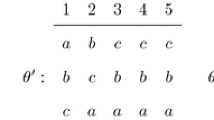Abstract
We explore the frontier between possibility and impossibility results by analyzing different combinations of “pro-socialness” and “consistency” conditions. This exercise delivers stronger versions of four classical impossibility theorems, and offers a thorough understanding of connections among them. We also characterize social choice functions that are “independent of irrelevant alternatives,” which makes evident that the fundamental difficulty of social choice lies in “pairwise” consistency requirements. We also introduce a concise pedagogical approach to classical impossibility theorems.

Similar content being viewed by others
Notes
When a society of 3 voters have preferences over 3 candidates as \(a_1\succ _1 a_2\succ _1 a_3\), \(a_2\succ _2 a_3\succ _2 a_1\), and \(a_3\succ _3 a_1\succ _3 a_2\) respectively, none of the candidates has a convincing case of winning. For instance, \(a_1\) would have lost to \(a_3\) in a “two-candidate runoff” determined by simple majority, if \(a_2\) dropped out of the race or become the least favored due to some devastating scandals. But \(a_3\) would have lost to \(a_2\), and \(a_2\) to \(a_1\), denying the existence of any “Condorcet winner.’
Available on my personal website: http://sites.google.com/site/neilningyu/. The readers can also consult Man and Takayama (2013) for interesting features when weak preferences are allowed–for example, serial dictatorship.
Mas-Colell, Whinston, and Green (1995, p. 808)
If \(F\) is a two-round system which automatically singles out two candidates first, it is desirable that \(A'\) enter the second round.
Gibbard (1973) employs this function in his proof.
Mathematically, when \(\vec {\succ }'=T_{ij}(\vec {\succ })\), for every \(n\), first, \(a_i\succ _n a_j\) if and only if \(a_i\succ '_n a_j\); second, \(a_i\succ '_n a_k\) and \(a_j\succ '_n a_k\) for every \(k\notin \{i,j\}\); third, \(a_l\succ _n a_m\) if and only if \(a_l\succ '_n a_m\) for every \(l,m\notin \{i,j\}\).
SPF dictatorship remains undefined until the section devoted to SPFs.
A referee suggested this condition.
(CRO) can be satisfied with the existence of multiple circles of alternatives winning runoffs in a circular manner.
This \(F\) honors the proverb “two dogs strive for a bone and the third one runs off with it.”
The statement bears a similar structure to a SPF theorem of Wilson (1972).
Had we defined dictatorship as the existence of an individual whose favorite in the range of the social choice function is always chosen, a discriminatory dictatorship would be a dictatorship. The purpose of the following exposition is to rigorously demonstrate that the central difficulty of social choice lies in pairwise consistency conditions. Barberá (1983) defines dictatorship as the existence of an individual whose favorite in the range of the SCF is always chosen–in which case a discriminatory dictatorship would always be a dictatorship. Claim 3 then follows from Barberà’s reformulation of the Gibbard–Satterwaite theorem (Barberá 1983, p. 415), since when \(M>3\), by (OM), the range of the SCF contains \(M-1>2\) elements.
Arrow and Raynaud (1986) apply social choice theory to expert systems.
The lemma fails when preferences are weak.
References
Arrow KJ (1950) A difficulty in the concept of social welfare. J Polit Econ 58(4):328–346
Arrow KJ (1959) Rational choice functions and orderings. Economica 26(102):121–127
Arrow KJ (1963) Social choice and individual values, 2nd edn. Wiley, New York
Arrow KJ, Raynaud H (1986) Social choice and multicriterion decision-making. MIT Press, Cambridge
Aswal N, Chatterji S, Sen A (2003) Dictatorial domains. Econ Theory 22(1):45–62
Barberà S (1980) Pivotal voters: a new proof of Arrow’s theorem. Econ Lett 6(1):13–16
Barberá S (1983) Strategy-proofness and pivotal voters: a direct proof of the Gibbard–Satterthwaite theorem. Int Econ Rev 24(2):413–417
Campbell DE (1992a) Implementation of social welfare functions. Int Econ Rev 33(3):525–533
Campbell DE (1992b) Transitive social choice in economic environments. Int Econ Rev 33(2):341–352
Campbell DE, Kelly JS (1993) t or 1 - t. that is the trade-off. Econometrica 61(6):1355–1365
Campbell DE, Kelly JS (2002) Chapter 1 Impossibility theorems in the Arrovian framework. In: Arrow KJ, Sen A, Suzumura K (eds) Handbook of social choice and welfare, vol 1. Elsevier, Amsterdam, pp 35–94
Condorcet Md (1785) Essai sur l’application de l’analyse à la probabilité des décisions rendues à la pluralité des voix. L’imprimerie Royale
Denicolò V (1993) Fixed agenda social choice theory: correspondence and impossibility theorems for social choice correspondences and social decision functions. J Econ Theory 59(2):324–332
Denicolò V (1998) Independent decisiveness and the Arrow theorem. Soc Choice Welf 15(4):563–566
Denicolò V (2000) Independence of irrelevant alternatives and consistency of choice. Econ Theory 15(1):221–226
Dutta B, Jackson MO, Breton ML (2001) Strategic candidacy and voting procedures. Econometrica 69(4):1013–1037
Geanakoplos J (2005) Three brief proofs of Arrow’s impossibility theorem. Econ Theory 26(1):211–215
Gibbard A (1973) Manipulation of voting schemes: a general result. Econometrica 41(4):587–601
Grether DM, Plott CR (1982) Nonbinary social choice: an impossibility theorem. Rev Econ Stud 49(1):143–149
Hansson B (1969) Voting and group decision functions. Synthese 20(4):526–537
Jackson MO, Srivastava S (1996) A characterization of game-theoretic solutions which lead to impossibility theorems. Rev Econ Stud 63(1):23–38
Kreps DM (1990) A course in microeconomic theory. Princeton University Press, Princeton
Kreps DM (2012) Microeconomic foundations I: choice and competitive markets. Princeton University Press, Princeton
Man P, Takayama S (2013) A unifying impossibility theorem. Econ Theory 54(2):249–271
Mas-Colell A, Whinston M, Green J (1995) Microeconomic theory. Oxford University Press, Oxford
Muller E, Satterthwaite MA (1977) The equivalence of strong positive association and strategy-proofness. J Econ Theory 14(2):412–418
Reny PJ (2001) Arrow’s theorem and the Gibbard–Satterthwaite theorem: a unified approach. Econs Lett 70(1):99–105
Samuelson L (1985) On the independence from irrelevant alternatives in probabilistic choice models. J Econ Theory 35(2):376–389
Satterthwaite MA (1975) Strategy-proofness and Arrow’s conditions: existence and correspondence theorems for voting procedures and social welfare functions. J Econ Theory 10(2):187–217
Sen A (2001) Another direct proof of the Gibbard–Satterthwaite theorem. Econ Lett 70(3):381–385
Sen AK (1970) Collective choice and social welfare. Holden-Day, San Francisco
Sen AK (1993) Internal consistency of choice. Econometrica 61(3):495–521
Wilson R (1972) Social choice theory without the pareto principle. J Econ Theory 5(3):478–486
Yu NN (2012) A one-shot proof of Arrow’s impossibility theorem. Econ Theory 50(2):523–525
Yu NN (2013) A one-shot proof of Arrow’s theorem and the Gibbard–Satterthwaite theorem. Econ Theory Bull 1(2):145–149
Acknowledgments
This paper benefited greatly from comments by Kenneth Arrow, Matthew Jackson, David Kreps, Paul Milgrom, Philip Reny, Larry Samuelson, Robert Wilson, Nicholas Yannelis, and seminar participants in Stanford university. I thank Mohammad Akbarpour, Josh Mollner, Yiqing Xing, Constantine Yannelis, anonymous referees, and the editor Clemens Puppe for their close readings and invaluable suggestions. I am also grateful for support of Koret Foundation Stanford Graduate Fellowship, Stanford Law School John M. Olin Program in Law and Economics, and National Natural Science Foundation of China (71073102 and 71273171).
Author information
Authors and Affiliations
Corresponding author
Appendix: An alternative proof of Arrow’s theorem and the Gibbard–Satterthwaite theorem
Appendix: An alternative proof of Arrow’s theorem and the Gibbard–Satterthwaite theorem
While some of the proofs below are well-known, we include them in order to demonstrate an alternative approach of proving classical impossibility theorems, which starts from the Hansson–Denicolò theorem. By contrast, Yu (2013) avoids the extra step of establishing the Muller–Satterthwaite theorem, and derives them from Theorem 4, which reveals the fundamental difficulty to be pairwise consistency requirements. But the definition of (CM) involves one more attributive than (IIA) does. As a result, Yu (2013) demands a higher level of mathematical maturity. When we compare these two approaches for teaching purposes, the tradeoff between succinctness and ease thus depends on the audience.
First, Arrow’s impossibility theorem (stated in Sect. 6) is a straightforward consequence of the Hansson–Denicolò theorem as shown by Denicolò (1993).
Proof of Arrow’s theorem
A SCF \(F^R\) is derived from \(R\) in that for any \(\vec {\succ }\), \(a_iR(\vec {\succ })a_j\) for every \(j\ne i\) is necessary and sufficient for \(F^R(\vec {\succ })=a_i\), i.e., it selects the alternative ranked highest by \(R\). \(F^R\) obviously satisfies (WP) and (IIA), so the Hansson-Denicolò theorem says that \(F^R\) presents a social choice dictator \(n\). She is a social preference dictator too. If \(a_i\succ _n a_j\), individual \(n\) rules \(F^R_{ij}(\vec {\succ })=a_i\), so \(a_iR(\vec {\succ })a_j\) by (SP-AIIA). \(\square \)
Based on the Hansson–Denicolò theorem, we prove the Muller–Satterthwaite theorem (stated in Sect. 5) directly, which is a popular pathway to the theorem of Gibbard (1973) and Satterthwaite (1975).Footnote 19 Denicolò (1993) does not offer this development.
Proof of Muller–Satterthwaite:
To show (IIA), let \(F\) satisfy (M) and \(\vec {\succ }\) and \(\vec {\succ }'\) agree on \(\{a_i, a_j\}\). Suppose \(F(\vec {\succ })=a_i\) and \(F(\vec {\succ }')=a_j\). By (M), \(F_{ij}(\vec {\succ })\) should be both \(a_i\) and \(a_j\), a contradiction.
Suppose that (WP) is violated, i.e., for some profile \(\vec {\succ }\), \(F(\vec {\succ })=a_j\), where \(a_i\) dominating \(a_j\). By (M), \(F_{ij}(\vec {\succ })=a_j\). By (O), there exists \(\vec {\succ }'\) such that \(F(\vec {\succ })=a_i\). By (M), \(F_{ij}(\vec {\succ })=a_i\), a contradiction. \(\square \)
When we replace the preferences of individual \(n\) in \(\vec {\succ }\) with \(\succ '_n\in \mathcal {P}\), denote the new profile \((\succ '_n,\vec {\succ }_{-n})\). Strategy-proofness ensures truth-telling by always switching to a worse alternative for an individual if only her misreport alters the outcome.
Definition 25
(SP). A SCF \(F\) is strategy-proof if \(F(\succ '_n,\vec {\succ }_{-n})\ne F(\vec {\succ })\) implies \(F(\vec {\succ })\succ _n F(\succ '_n,\vec {\succ }_{-n})\) for every \(n\), every \(\vec {\succ }\), and every \(\succ '_n\).
Theorem 11
(Gibbard–Satterthwaite). If \(F\) satisfies (O) and (SP), then it is dictatorial.
Proof
It is a consequence of Theorem 5 and the sufficiency part of Lemma 10. \(\square \)
Muller and Satterthwaite (1977) demonstrate the equivalence of (SP) and (M). Our proof of the claim that (M) implies (SP) is shorter than the original version.
Lemma 10
\(F\) satisfies (M) if and only if it satisfies (SP).Footnote 20
Proof
Sufficiency: Let \(F(\vec {\succ })=a_i\) and \(\vec {\succ }'\) maintain \(a_i\)’s positions in \(\vec {\succ }\). Define \(\vec {\succ }''\equiv (\succ '_1,\vec {\succ }_{-1})\), then \(\vec {\succ }=(\succ _1,\vec {\succ }''_{-1})\). Suppose \(a_j=F(\vec {\succ }'')\ne a_i\). (SP) demands \(a_i\succ _1 a_j\) and \(a_j\succ '_1 a_i\), so \(\vec {\succ }'\) lowers \(a_i\)’s positions relative to \(a_j\) for individual \(1\), contradicting the assumption. So \(F(\vec {\succ }'')=a_i\). Following the same logic, we can update \(\vec {\succ }\) to \(\vec {\succ }'\) one by one without altering the choice.
Necessity: Suppose \(a_i=F(\succ '_n,\vec {\succ }_{-n})\succ _nF(\vec {\succ })=a_j\). Consider \(\succ ''_n\) with \(a_i\succ ''_na_j\succ ''_na_k\) for every \(k\notin \{i,j\}\). We have \((\succ ''_n,\vec {\succ }_{-n})\) maintains \(a_i\)’s position in \((\succ '_n,\vec {\succ }_{-n})\) and \(a_j\)’s position in \(\vec {\succ }\), but \(F(\succ ''_n,\vec {\succ }_{-n})\) cannot be both \(a_i\) and \(a_j\). \(\square \)
Rights and permissions
About this article
Cite this article
Yu, N.N. A quest for fundamental theorems of social choice. Soc Choice Welf 44, 533–548 (2015). https://doi.org/10.1007/s00355-014-0846-3
Received:
Accepted:
Published:
Issue Date:
DOI: https://doi.org/10.1007/s00355-014-0846-3




